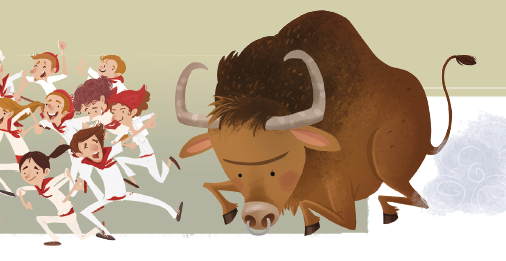Spain’s running of the bulls: the good, the bad and the ugly
Thousands of people risk their lives each year at the running of the bulls in Spain during the nine-day festival of San Fermin in Pamplona from July 6 to 14. Here’s what you need to know!
What happens?
More than a million tourists visit Pamplona to see the bull runs or “encierros” in Spanish. They are a big part of summer festivals in Spain. Bull runs happen during eight mornings where people race with bulls along a street course to the bullring. During the afternoon bullfights, the bulls face matadors and certain death.
How far is the run?
The run begins on Pamplona’s Santa Domingo street and finishes in the Plaza de Toros, where the bullpen is located. The run is a little over a half-mile. For speedy runners, the course should only take a few minutes to complete. If participants make it to the bullpen, they can continue to run around the arena with the bulls.
What do people wear?
Participants traditionally wear all white with a red scarf to honour San Fermin. Religious customs show priests would dress in red to honour saints. Red is also the colour associated with charging bulls in bullfights.
Can anyone participate?
Men and women age 18 and older can run with the bulls. A rule change in 1974 allowed women to participate in what had been a male-only event. There are also festivities for children. At 10 p.m. each day, children have their own encierro where they can run with a fake bull stuffed with fireworks.
How dangerous is the event?
Dozens of people are injured each year, most often trampled by the bulls. Last year, 12 people, including four Americans, were gored during the bull runs. Since record-keeping began in 1924, 15 people have died after being gored at the festival.
What is the significance of San Fermin?
The festival originally occurred in September each year, but was changed in 1592 to start in July. It combines religious and celebratory components to honour San Fermin, or St. Fermin, who was the first bishop of Pamplona.
Why are there protests against the festival?
Animal rights organisations, including PETA, claim that workers use electric prods and sharp sticks to agitate the bulls before releasing them into the streets. Activists covered in fake blood have protested in the past and campaigned for an end to bull fighting. Pamplona is in Catalonia which is an autonomous region in Spain. The region banned bullfighting in 2010 following a campaign by animal rights groups. A poll at the time showed 60% of Spaniards said they didn’t like bullfighting, while 57% also said they were against the ban because it was going against Spanish tradition.

